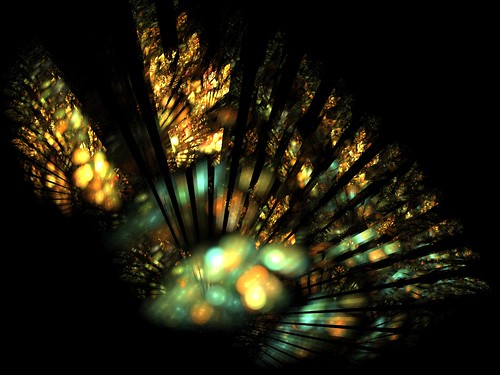
Fandango: A Dance of Light, originally uploaded by Lynn (Gracie's mom) - I'm here & there.
Fandango is a lively folk and flamenco couple-dance usually in triple metre, traditionally accompanied by guitars and castanets or hand-clapping (palmas in Spanish). Fandango can both be sung and danced. The sung fandango is usually bipartite: it has an instrumental introduction followed by "variaciones". Sung fandango usually follows the structure of "cante" that consist of four or five octosyllabic verses (coplas) or musical phrases (tercios). Occasionally the first copla is repeated...
The metre of fandango is similar to that of the bolero and seguidilla. It was originally notated in 6/8 time, but later in 3/8 or 3/4.
Origins
Fandango's origins are uncertain, as is the etymology of the term, that probably comes from 16th century Portugal, where the word 'esfandangado' denoted a popular song. The earliest fandango melody is found in the anonymous "Libro de diferentes cifras de guitarra" in 1705), and the earliest description of the dance itself is found in a 1712 letter by Martín Martí, a Spanish priest. Fandango's first sighting in a theatrical work was in Francisco de Leefadeal's "Entremés El novio de la aldeana" staged in Seville, ca. 1720. By the late 18th century it had become fashionable among the aristocracy and was often included in tonadillas, zarzuelas, ballets and operas, not only in Spain, but also elsewhere in Europe.
Widely varying claims have been made about the origin of fandango: its relation to the soléa, jabera and petenera; to the Andalusian malagueña, granadina, murciana and rondeña; to the canario and gitano; to the jota aragonesa. There have suggestions of a Moorish origin. Currently the prevailing theories point to either a West Indian or Latin American origin.
Fandangos de Lucena y Cabra
Provenance: Córdoba
It is a variety of the 'fandango abandolao' characteristic of villages of Cordoba. Three different styles can be found in Lucena, of: Dolores de la Huerta, Rafael Rivas, and La Calle Rute. Cayetano Muriel from Cabra, stands out as its creator and disseminator
To listen to the items, click on the icon
Download
Fandangos de Frasquito Yerbagüena
Provenance: Granada
Variety of the 'fandango abandolao' created by Frasquito Yerbagüeña from Granada and demands great ability in artists due to the tessitura and its melodic changes. Actually it is used a lot to finish the 'malagueñas'.
To listen to the items, click on the icon
Download
Fandangos
Provenance: Almería, Cádiz, Córdoba, Granada, Huelva, Jaén, Málaga, Sevilla
For some theorists, this song is the most primitve that exists. Its structured on a beat of 3/4 and has a great tonal variety. They are 'coplas' of five, eight syllable, verses that usually convert into six by the repetition of one of them. It seems that the 'fandango onubense' came from Alosno, and from there was distributed through Andévalo, the mountain range and the capital. From this it has been possible to study an infinite number of different styles, four particular artists being underlined: José Rebollo, Paco Isidro, Antonio Rengel and Paco Toronjo. Within some of the best known styles are those of 'Alosno', 'choqueros', 'Almonaster', 'Santa Eulalia', 'Cerro del Andévalo', Encinasola', 'Calañas' and 'Cabezas Rubias'.
To listen to the items, click on the icon
Download
Download
Download
Download
Download
Download
Download
Download
Download
Download
Download
Download
Download
Fandangos de Huelva
Provenance: Huelva
To listen to the items, click on the icon
Download
Download
Download
Download
Download
Download
Download
Download
Download
Download
Download
Download
Download
Download
Download
Download
Download

No comments:
Post a Comment